#Eruption 🌋 of Fagradalsfjall Volcano 🌋
Explore tagged Tumblr posts
Text

Fagradalsfjall Volcano Erupting in July. In 2021, Fagradalsfjall erupted for the first time in about 800 years, kickstarting a new era in volcanic activity in Iceland 🇮🇸. Image credit: Anadolu Agency/Getty Images
'Time's Finally up': Impending Iceland Eruption is Part of Centuries-Long Volcanic Pulse
Iceland's Reykjanes Peninsula is now in a new era of volcanic eruptions that will last for up to 500 years, and the building magma beneath Sundhnúkur and Grindavík is part of this millenia-long cycle.
— By Hannah Osborne | Live Science
Iceland's potentially imminent eruption in the Reykjanes Peninsula is part of a 1,000-year cycle of volcanic activity that will likely cause eruptions for centuries, scientists say.
"Time's finally up," Edward W. Marshall, a researcher at the University of Iceland's Nordic Volcanological Center, told Live Science in an email. "We can get ready for another few hundred years of eruptions on the Reykjanes."
Seismic activity began increasing in the south of the peninsula in October, with hundreds of earthquakes recorded there each day. On Nov. 10, authorities evacuated the town of Grindavík, with experts warning an volcanic eruption could take place in just days.

Infographic showing the seismic activity that has hit Iceland in recent weeks. Image credit: Anadolu Agency/Getty Images
According to the Icelandic Met Office (IMO), a magma tunnel stretching 9.3 miles (15 kilometers) formed beneath the ground between Sundhnúkur in the north and Grindavík. The area affected also encompasses the Blue Lagoon geothermal spa — a tourist hotspot that attracts hundreds of thousands of visitors annually.
Magma in the tunnel — also known as a dike — appears to be rising to the surface, and there is a high risk of it breaking through. The greatest area of magma upwelling is currently close to Sundhnúkur, about 2 miles (3.5 km) northeast of Grindavík, according to the IMO. Researchers believe the amount of magma in the tunnel is "significantly more" than what was present during the eruptions at Fagradalsfjall, which sparked back to life in 2021 after more than 800 years of inactivity.
That 2021 eruption marked the start of a new cycle of volcanic activity on the Reykjanes Peninsula. Geological records show periods of inactivity last between 600 and 1,200 years, which is then followed by pulses of eruptions lasting between 200 and 500 years, Clive Oppenheimer, a professor of volcanology at the University of Cambridge in the U.K., told Live Science in an email.
"It looks like 2021 kicked off a new eruptive phase which might see the several fault zones crossing the [Reykjanes Peninsula] firing on and off for centuries," he said.

Grindavík has been evacuated over fears an eruption may take place in or near the town. Image credit: Kjartan Torbjoernsson/Getty Images
The Reykjanes Peninsula sits above two tectonic plates that are being pulled apart. The strain that builds up is released in bursts as part of the cycle. "We are now in one of these pulses," David Pyle, a volcanologist and professor of Earth sciences at the University of Oxford, U.K, told Live Science in an email. "Each eruption releases just a bit more of the stored-up strain, and eventually, when all of that strain has been released, then the eruptions will stop."
It is currently unclear if an eruption will take place as a result of the magma tunnel. "These sorts of dikes are actually a tectonic, not a magmatic feature. In other words, the lava is filling a fracture, not forcing its way into the rock," Marshall said.
Should a fissure emerge, an eruption could last for several weeks. The large amount of magma involved compared with previous eruptions in the region could result in more lava flow at the surface, Oppenheimer said.
What happens next is a waiting game, Marshall said. "I predict — if an eruption occurs — that it will occur between a few days to threeish weeks. If it hasn't erupted in three weeks, I don't think it will happen. Cooling will begin to close the fractures."
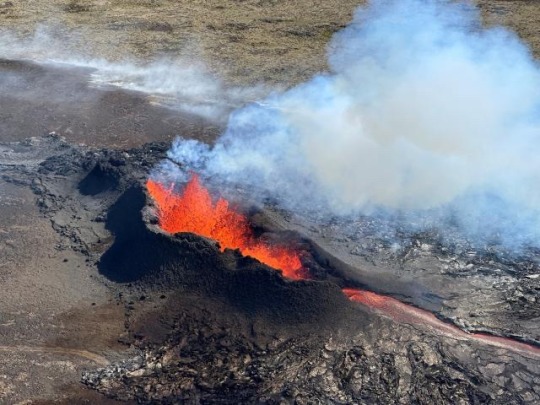
— Hannah Osborne is the planet Earth and Snimals Editor at Live Science. She worked for several years at Newsweek and at International Business Times U.K. as the Science Editor. Hannah holds a Master's in Journalism from Goldsmith's, University of London.
#Iceland 🇮🇸#Fagradalsfjall Volcano 🌋#Volcanic Activity#Eruption 🌋 of Fagradalsfjall Volcano 🌋#Hannah Osborne#Live Science
29 notes
·
View notes
Text
🌋 Exploring Iceland’s Volcanic Landscapes 🌍
Iceland is a land of fire and ice, where rugged volcanic landscapes meet stunning glaciers and geothermal hot springs. From the explosive eruptions to the lava fields, this island offers nature’s raw power like no other place on Earth. 🌋🔥
🌟 Must-see volcanic spots in Iceland:
Þingvellir National Park – Tectonic plates at work!
Hekla Volcano – One of the most active volcanoes.
Fagradalsfjall – The recent eruption made this a must-visit.
Krafla Lava Fields – A surreal landscape.
Askja Crater – A hidden gem in the highlands.
💡 Get ready for an unforgettable adventure where every step is a reminder of the Earth's incredible forces!
#IcelandVolcanoes #TravelIceland #VolcanicLandscapes #TierTravels #ExploreMore #NatureAtItsBest

3 notes
·
View notes
Text
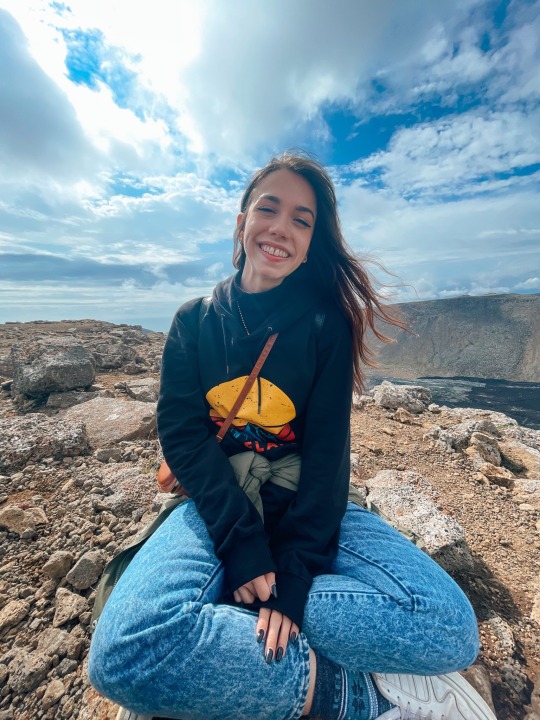
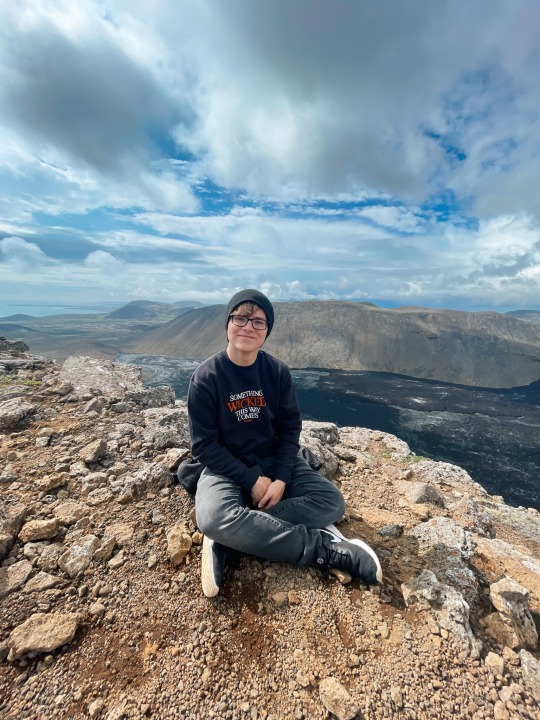

Not me visiting Fagradalsfjall volcano only days before it erupted. 🌋 I didn’t get any photos too close to the edge but all that black stuff is lava from last year’s eruption. & you can’t tell, because it kind of just looks like Austin is sitting right next to a small stream of lava, BUT it’s like hundreds of feet down and he’s just sitting on the very edge and that’s a very large stream of lava.
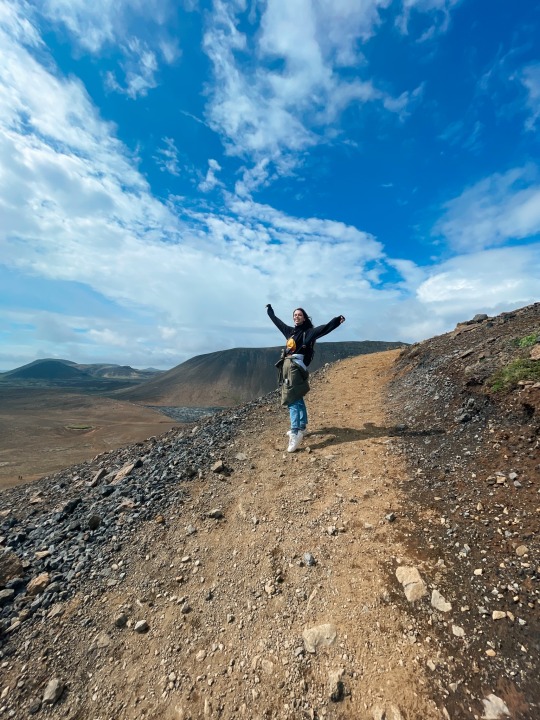
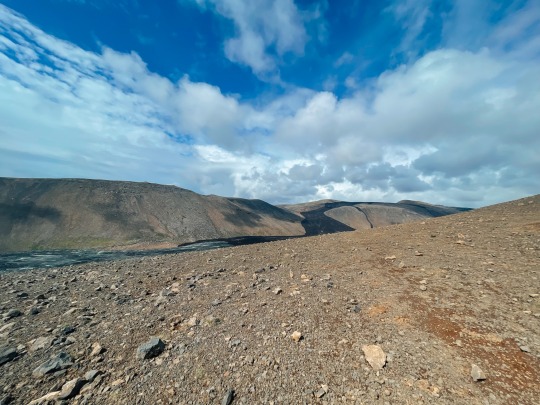
#photography#volcano#fagradalsfjall#iceland#reykjavík#study abroad#travel journal#travel blog#traveling#travel writing#travel#lava#eruption#loustella perry
12 notes
·
View notes
Video
Craziest Volcano in ICELAND 🌋 Fagradalsfjall Volcano Eruption. Iceland V...
0 notes
Photo

This astounding footage by @hemmi90 shows the Fagradalsfjall Volcano erupting in late August. Since

This astounding footage by @hemmi90 shows the Fagradalsfjall Volcano erupting in late August. 🌋 Since its eruption in March this year, the volcano continues to show signs of activity, and as a result, its surrounding area is constantly changing. 😮 Have you ever visited this famous volcano in Iceland? 🇮🇸 📽 @hemmi90 📍 Fagradalsfjall Volcano, Reykjanes Peninsula, Iceland 🎶 Leona Lewis - Now We Are Free (From "Gladiator")
Note: All rights belong to their respective owners #livenews, #cablenews, #usnews, #businessnews, #worldnews, #news, #eveningnews, #nightlynews, #breakingnews, #nightlynewsnbc, #nbcnewsnow, #newsnbc, #nbcnewslive, #nbcnewstoday, #newstoday, #newsstation, #stockmarket, #nbcnewslivetoday, #newsnbclive, #nbcnewslivestream, #nbcnewsspecialreport, #newswithshepardsmith, #coroner, #nbclive, #nbc, #abc, #nbcspecialreport, #report, #Iamlatest #latesttrend #latestnews #latestissue #latestart #latestpicture #latestupdate #FoxNews #CNN #SkyNews #AlJazeera #BBC #MSNBC #Euronews #GeoNews #NDTVIndia
0 notes
Text

Photographed on July 11, 2023—the Fagradalsfjall Volcano's gas cloud stretches over the Litli-Hrútur mountain and is illuminated at sunset. Smoke from nearby lava-ignited moss fires blow into the valley below. Photograph By Mike Mezeul II Photography
Iceland 🇮🇸 Has Entered A New Volcanic Era
The country’s volcanic peninsula has been dormant for centuries. But experts say the tectonic shifts behind the recent eruptions and earthquakes are a long time coming.
By Robin George Andrews | July 24, 2023
For centuries, the country’s western volcanic peninsula has been dormant, but a new era of volcanic activity could be on the horizon.
The Fagradalsfjall Volcano, a raised crater of bubbling lava—glowing bright yellow in an expanse of dark gray—is the latest eruption heralding Iceland’s new period of volcanic activity.
The eruption announced its approach on July 4 of this year, when southwest Iceland was rocked by more than 2,000 earthquakes in just 24 hours. Not long after, seismic activity dropped off as magma rose to shallow depths and ultimately gave way to oozing molten rock on July 10.
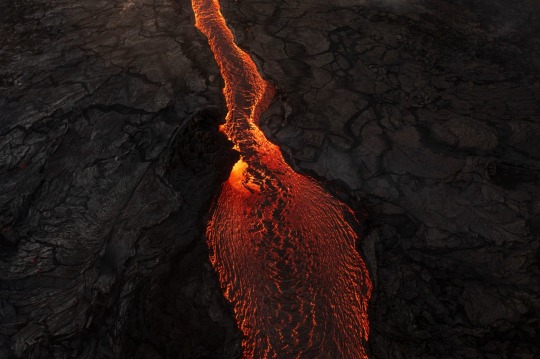
A river of lava cuts its way through the valley in between the Keilir and Litli-Hrútur mountains on the Reykjanes Peninsula. Photograph By Mike Mezeul II Photography
Located next to the small mountain of Litli-Hrútur, this eruption is taking place on Reykjanes, a volcanically active peninsula that has become a popular destination among tourists looking to see lava fountaining above and pouring onto the surface. However, the site of the new eruption is potentially hazardous—new fissures may open nearby without warning, rivers of lava can form at a quick pace, and toxic gas can quickly fill the air, according to the Iceland Met Office.
This eruption is the peninsula’s third volcanic paroxysm in a row, following on from similar lava-spewing eruptions in 2021 and 2022—and it’s unlikely to be the last.
After an eruption last summer, Dave McGarvie, a volcanologist at Lancaster University, told National Geographic that the recent uptick in volcanic activity, “... could herald the start of decades of occasional eruptions.”

A lava flow smolders, glowing red through black volcanic rock. While the Icelandic government has warned that this latest eruption is hazardous to visitors, the region is a popular destination for volcanic tourism. Photograph By Chris Burkard, Verb Photo
Iceland’s Volcanic Geology
The Reykjanes Peninsula lies about 17 miles southwest of Iceland’s capital city Reykjavik. It sits atop the continually spreading Mid-Atlantic Ridge, where the North American plate to the west and the Eurasian plate to the east are gradually pulling apart. Superhot, gassy magma, which is less dense than the surrounding rock, can sometimes rise into the shallow crust from buoyancy alone, but all that regional stretching also creates cracks where molten rock can infiltrate.
The peninsula’s subterranean bedlam seems to manifest as periodic busts of volcanism. Historical accounts and studies of ancient volcanic rocks show that times of volcanic repose transition into loud seismic and eruptive awakenings in a cycle that’s transpired several times in the past few millennia.
Although the region had been volcanically dormant for centuries, the tectonic sundering happening in the depths meant that the latest eruptions have long been in the works.
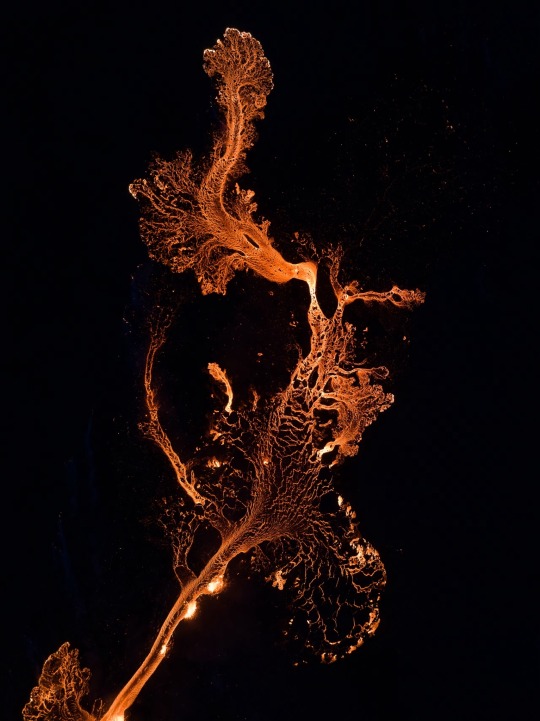
An aerial view shows the new volcanic eruption at Litli Hrútur. Geological changes normally take thousands of years, but here at the volcano, where new land is forming, the earth changes rapidly as fissures open up, and molten lava spills across the landscape. Photograph By Karim Iliya, Verb Photo
A Fiery New Beginning
And in recent years, several sheets of magma ascended toward the surface, indicated by the changing shape of the ground and swarms of earthquakes, says Tobias Dürig, a volcanologist at the University of Iceland. But for some time, these magmatic serpents failed to see sunlight—their escape was stymied either from the loss of their own upward momentum or because the resilient crust didn’t offer an escape hatch.
Nevertheless, as earthquakes began to crescendo in both frequency and strength from late 2019 onwards, scientists suspected that an eruption sometime in the future seemed inevitable. That was confirmed in dramatic fashion on March 19, 2021, when lava began gushing from a 1,650-foot-long fissure in a valley of the Geldingadalur region.
These ferocious fires are gifting scientists with an unparalleled look at the connective tissue between the igneous abyss below and the lava-licked landscape above. Their efforts help improve our understanding of Earth’s viscera, of Iceland’s volcanic cadence, and of this peninsula’s volcanic dangers.

An aerial view of the main cinder cone that has formed from the 2023 Fagradalsfjall Volcano eruption in Iceland. Photograph By Mike Mezeul II Photography
Iceland 🇮🇸 Eruption May Be the Start of Decades of Volcanic Activity
A second outburst of lava in under a year strongly suggests that the country’s Reykjanes Peninsula will become one of the most volcanically dynamic parts of the planet for several generations. (Some More Photographs August 2022)
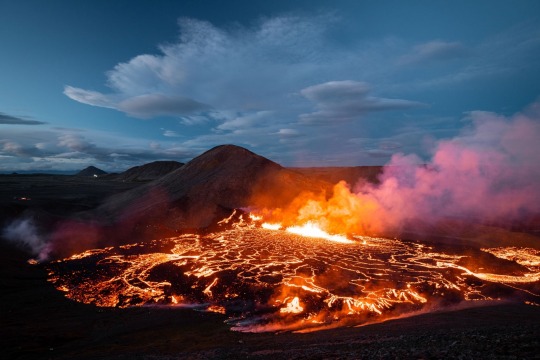
After centuries of quiescence, Iceland's Reykjanes Peninsula has erupted twice in less than a year, sending up fountains of incandescent rock. The latest eruption, which started at 1:18 p.m. local time on August 3, 2022, opened up at a fissure only a few hundred feet away from the cone crafted by last year’s volcanic outburst.

The incandescent rock is erupting with greater vigor than last year's outburst, but what the volcano will do in the days ahead—including how long this eruption will last—remains unknown. A small plane at the bottom of this image illustrates the scale of the new eruption. (August 2022)
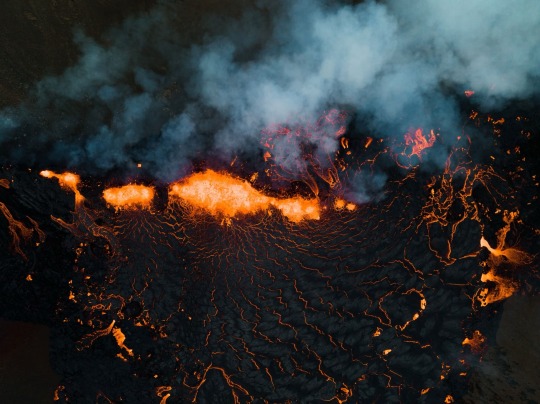
While the volcano currently poses little risk, authorities are keeping a close watch on the changing hazards. In the image below, members of the Icelandic Association for Search and Rescue are seen investigating the dangers near the lava's edge. (August 2022)
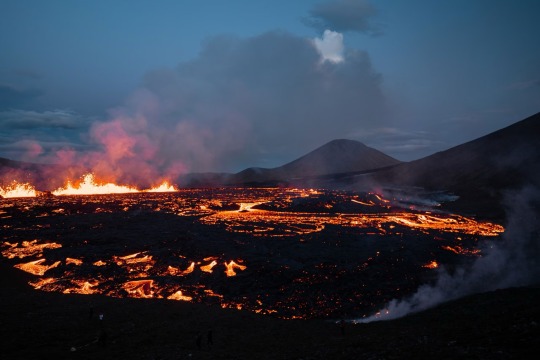
The sputtering lava has already begun building small mounds of spatter near the fissure and filling the valley with a pool of molten rock. It’s unclear for now if the lava will remain confined to these valleys or will travel further afield, perhaps reaching the sea. But for now, says Evgenia Ilyinskaya, a volcanologist at the University of Leeds, the eruption is providing scientists with “a fantastic natural experiment.” (August 2022)
#Volcanoes 🌋#Iceland 🇮🇸#Volcanic Peninsula#Volcanic Activity#Fagradalsfjall Volcano 🌋#Eruptions#Earthquakes#Potentially Hazardous#Fissures#Dave McGarvie#Lancaster University#The National Geographic#Litli-Hrútur#Reykjanes#Iceland 🇮🇸 Met Office#Geological Changes#Earth’s Viscera
0 notes
Video
Craziest Volcano in ICELAND 🌋 Fagradalsfjall Volcano Eruption. Iceland Volcano LIVE 2021
#volcano#eruption#lava#lava flow#iceland#iceland travel#iceland volcano#magma#natural disasters#live
1 note
·
View note